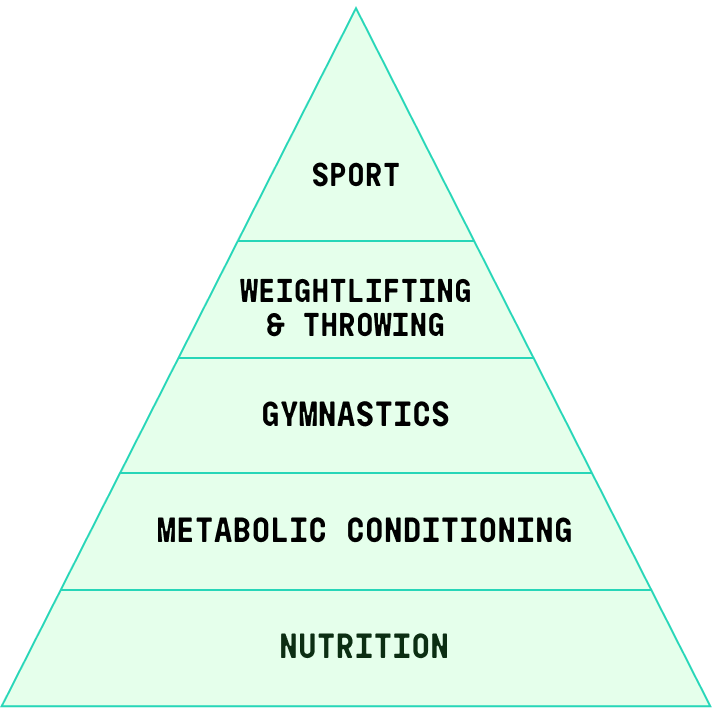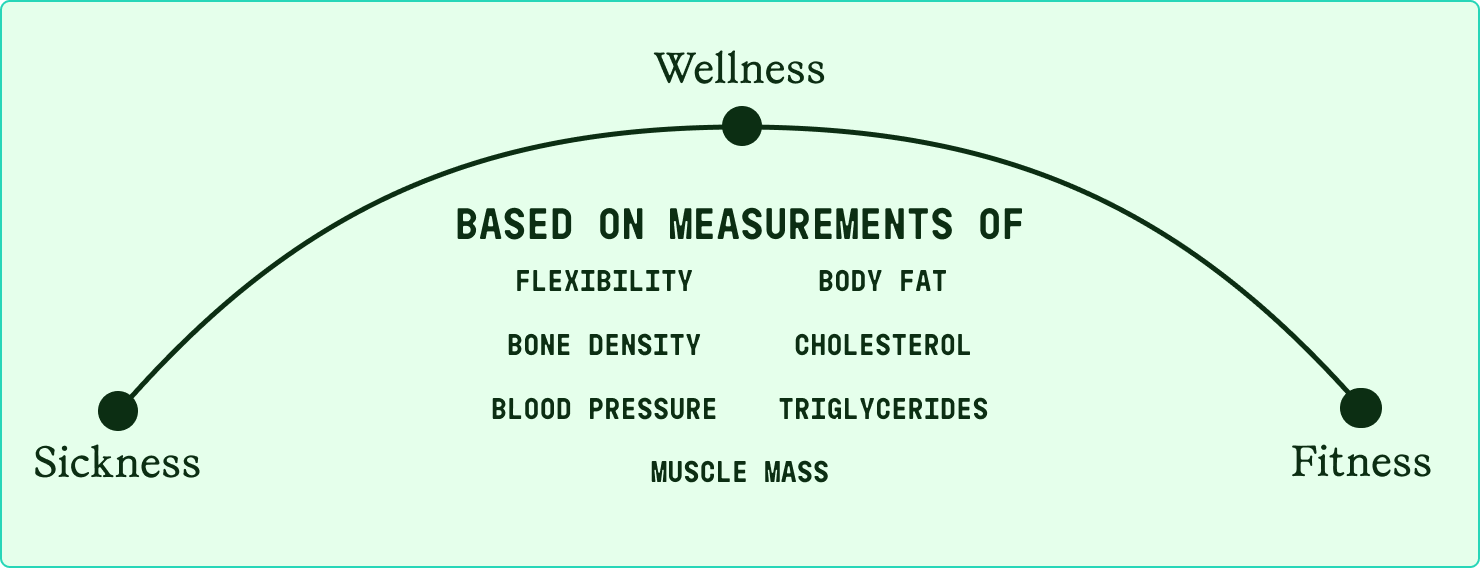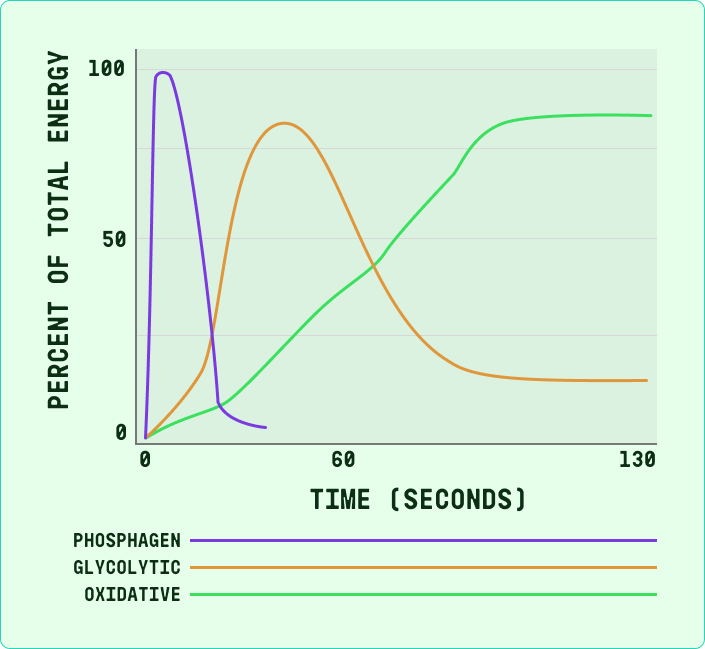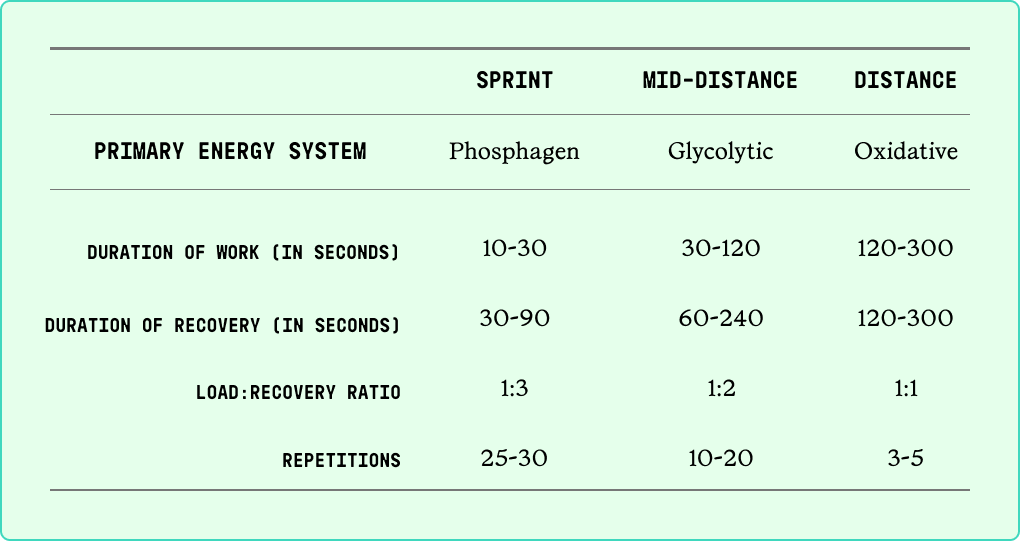What is Fitness?
Summary
CrossFit puts for a definition of health and fitness that goes beyond just the absence of disease or the ability to transmit genes.
To be able to make progress in your fitness, you need to be able to measure it. This is what CrossFit sets out to do.
This article is a higher-level exploration of what fitness means to CrossFit.
Fitness is broken down into 3 intertwined models:
- The 10 general physical skills
- The hopper model
- The metabolic pathways
Each model evaluates fitness in a different lense and are useful for different purposes.
But before diving into the individual models, all you really need to know to develop fitness is “World-Class Fitness in 100 Words”:
Eat meat and vegetables, nuts and seeds, some fruit, little starch and no sugar. Keep intake to levels that will support exercise but not body fat.
Practice and train major lifts: Deadlift, clean, squat, presses, C&J, and snatch. Similarly, master the basics of gymnastics: pull-ups, dips, rope climb, push-ups, sit-ups, presses to handstand, pirouettes, flips, splits, and holds. Bike, run, swim, row, etc, hard and fast.
Five or six days per week mix these elements in as many combinations and patterns as creativity will allow. Routine is the enemy. Keep workouts short and intense.
Regularly learn and play new sports.
-Greg Glassman

The idea behind building world class fitness in this manner is you are building a pyramid of fitness. The base of the pyramid is nutrition, then metabolic conditioning, gymnastics, weightlifting, and finally sport.
As you move your way up the pyramid, you are moving various measures of fitness from sickness to wellness to fitness.

The 10 General Physical Skills
The 10 general skills build off the pyramid of fitness you see above.
The skills are:
- 1. Cardiovascular/respiratory enduranceThe ability of body systems to gather, process, and deliver oxygen.
- 2. StaminaThe ability of body systems to process, deliver, store, and utilize energy.
- 3. StrengthThe ability of a muscular unit, or combination of muscular units, to apply force.
- 4. FlexibilityThe ability to maximize the range of motion at a given joint.
- 5. PowerThe ability of a muscular unit, or combination of muscular units, to apply maximum force in minimum time.
- 6. SpeedThe ability to minimize the time cycle of a repeated movement.
- 7. CoordinationThe ability to combine several distinct movement patterns into a singular distinct movement.
- 8. AgilityThe ability to minimize transition time from one movement pattern to another.
- 9. BalanceThe ability to control the placement of the bodies center of gravity in relation to its support base.
- 10. AccuracyThe ability to control movement in a given direction or at a given intensity.
You are as fit as you are competent in each of these 10 skills. You increase your fitness in one skill which increases your overall fitness.
They are grouped into 3 categories based generally on how you improve them:
The first 4 skills are improved through training. Training is activity that improves performance through a measurable organic change in the body. In other words, you’re able to keep your heart rate lower for longer.
The last 4 skills are improved through practice. Practice is activity that improves performance through changes in the nervous system.
And the middle 2 skills, Power & Speed, are improved through both training and practice.
The Hopper Model
The hopper model is the idea that you should be prepared to perform well at any task, or combination of tasks, that are demanded of you. You might need to hike 10 miles with a ruck on or move bricks from one side of the yard to the other. CrossFit prepares you for both.
The Metabolic Pathways
There are 3 metabolic pathways that your body utilizes to produce energy to perform a task.
These pathways are:
- phosphagen
- glycolytic
- oxidative
Phosphagen is the pathway utilized for very short bursts of energy. Think 1 rep max efforts or 100m sprints. 100% redline effort.
Glycolytic is the pathway utilized for medium length bursts of energy. Think 400m sprints or 1 minute max effort on the rower. 80-90% effort.
Oxidative is the pathway utilized for long duration efforts. Think 5k runs or 30 minute row. 60-70% effort.
Phosphagen and Glycolytic are both anaerobic pathways while Oxidative is an aerobic pathway.
The goal is to develop all 3 pathways while avoiding training one or two at the exclusion of the others.
With this being said the bulk of metabolic training should be anerobic interval training which allows you to develop better cardio without an unacceptable loss of strength, speed, and power.
Below are a graph and charts describing the metabolic pathways:


Highlights
-
[page 1]: Merriam Webster’s Collegiate Dictionary defines “fitness” and being “fit” as the ability to transmit genes and being healthy.
-
[page 1]: The vacuum of guiding authority has therefore necessitated that CrossFit’s directors provide their own definition of fitness.
-
[page 1]: CrossFit makes use of three different standards or models for evaluating and guiding fitness. Collectively, these three standards define the CrossFit view of fitness.
-
[page 1]: ten general physical skills widely recognized by exercise physiologists.
-
[page 1]: based on the performance of athletic tasks,
-
[page 1]: Each model is critical to the CrossFit concept and each has distinct utility in evaluating an athlete’s overall fitness or a strength and conditioning regimen’s efficacy.
-
[page 1]: Eat meat and vegetables, nuts and seeds, some fruit, little starch and no sugar. Keep intake to levels that will support exercise but not body fat. ■ Practice and train major lifts: Deadlift, clean, squat, presses, C&J, and snatch. Similarly, master the basics of gymnastics: pull-ups, dips, rope climb, push-ups, sit-ups, presses to handstand, pirouettes, flips, splits, and holds. Bike, run, swim, row, etc, hard and fast. ■ Five or six days per week mix these elements in as many combinations and patterns as creativity will allow. Routine is the enemy. Keep workouts short and intense. ■ Regularly learn and play new sports.
-
[page 2]: cardiovascular/respiratory endurance, stamina, strength, flexibility, power, coordination, agility, balance, and accuracy
-
[page 2]: You are as fit as you are competent in each of these ten skills.
-
[page 2]: improvements in endurance, stamina, strength, and flexibility come about through training. Training refers to activity that improves performance through a measurable organic change in the body.
-
[page 2]: improvements in coordination, agility, balance, and accuracy come about through practice.
-
[page 2]: Practice refers to activity that improves performance through changes in the nervous system. Power and speed are adaptations of both training and practice.
-
[page 2]: The essence of this model is the view that fitness is about performing well at any and every task imaginable. Picture a hopper loaded with an infinite number of physical challenges where no selective mechanism is operative, and being asked to perform fetes randomly drawn from the hopper.
-
[page 2]: fitness requires an ability to perform well at all tasks, even unfamiliar tasks, tasks combined in infinitely varying combinations
-
[page 2]: Nature frequently provides largely unforeseeable challenges; train for that by striving to keep the training stimulus broad and constantly varied.
-
[page 2]: There are three metabolic pathways that provide the energy for all human action. These “metabolic engines” are known as the phosphagen pathway, the glycolytic pathway, and the oxidative pathway.
-
[page 2]: Total fitness, the fitness that CrossFit promotes and develops, requires competency and training in each of these three pathways or engines.
-
[page 2]: Favoring one or two to the exclusion of the others and not recognizing the impact of excessive training in the oxidative pathway are arguably the two most common faults in fitness training.
-
[page 2]: Our first model evaluates our efforts against a full range of general physical adaptations, in the second the focus is on breadth and depth of performance, with the third the measure is time, power and consequently energy systems.
-
[page 2]: ensure the broadest and most general fitness possible
-
[page 2]: Our specialty is not specializing.
-
[page 3]: our assumption is that if everything we can measure about health will conform to this continuum then it seems that sickness, wellness, and fitness are different measures of a single quality: health.
-
[page 3]: every measurable value of health can be placed on a continuum that ranges from sickness to wellness to fitness
-
[page 3]: Though tougher to measure, we would even add mental health to this observation. Depression is clearly mitigated by proper diet and exercise, i.e., genuine fitness.
-
[page 3]: We observe a similar ordering for bone density, triglycerides, muscle mass, flexibility, HDL or “good cholesterol”, resting heart rate, and dozens of other common measures of health.
-
[page 3]: Sickness, wellness, and fitness are measures of the same entity.
-
[page 3]: Our fitness, being “CrossFit”, comes through molding men and women that are equal parts gymnast, Olympic weightlifter, and multi-modal sprinter or “sprintathlete.”
-
[page 4]: Aerobic training benefits cardiovascular function and decreases body fat – all good. Aerobic conditioning allows us to engage in low power extended efforts efficiently (cardio/respiratory endurance and stamina). This is critical to many sports.
-
[page 4]: Anaerobic activity also benefits cardiovascular function and decreases body fat! In fact, anaerobic exercise is superior to aerobic exercise for fat loss!
-
[page 4]: Anaerobic activity is, however, unique in its capacity to dramatically improve power, speed, strength, and muscle mass. Anaerobic conditioning allows us to exert tremendous forces over brief time intervals.
-
[page 4]: anaerobic conditioning will not adversely affect aerobic capacity.
-
[page 4]: anaerobic activity can be used to develop a very high level of aerobic fitness without the muscle wasting consistent with high volumes of aerobic exercise!!
-
[page 4]: The key to developing the cardiovascular system without an unacceptable loss of strength, speed, and power is interval training.
-
[page 4]: Note that the phosphagen pathway is the dominant pathway in intervals of 10-30 seconds of work followed 4
-
[page 5]: October 2002 by rest of 30-90 seconds (load:recovery 1:3) repeated 25-30 times.
-
[page 5]: The glycolytic pathway is the dominant pathway in intervals of 30-120 seconds work followed by rest of 60-240 seconds (load: recovery 1:2) repeated 10-20 times.
-
[page 5]: And finally, the oxidative pathway is the dominant pathway in intervals of 120-300 seconds work followed by rest of 120-300 seconds (load:recovery 1:1). The bulk of metabolic training should be interval training.
-
[page 5]: It is highly desirable to regularly experiment with interval patterns of varying combinations of rest, work, and repetitions.
-
[page 5]: The first wave is increased maximal oxygen consumption. The second is increased lactate threshold. The third is increased efficiency. In the CrossFit concept we are interested in maximizing first wave adaptations and procuring the second systemically through multiple modalities, including weight training, and avoiding completely third wave adaptations. Second and third wave adaptations are highly specific to the activity in which they are developed and are detrimental to the broad fitness that we advocate and develop.
-
[page 5]: A clear understanding of this material has prompted us to advocate regular high intensity training in as many training modalities as possible through largely anaerobic efforts and intervals while deliberately and specifically avoiding the efficiency that accompanies mastery of a single modality.
-
[page 5]: with interval training we get all of the cardiovascular benefit of endurance work without the attendant loss of strength, speed, and power.
-
[page 5]: The starting place for gymnastic competency lies with the well-known calisthenic movements: pull-ups, push-ups, dips, and rope climb.
-
[page 6]: At fifteen pull-ups and dips each it is time to start working regularly on a “muscle-up.”
-
[page 6]: With a muscle-up you’ll be able to surmount any object on which you can get a finger hold – if you can touch it you can get up on it. The value here for survival, police, fire fighter, and military use is impossible to overstate.
-
[page 6]: a large measure of balance and accuracy can be developed through mastering the handstand.
-
[page 6]: After you can hold a handstand for several minutes without benefit of the wall or a spotter it is time to develop a pirouette.
-
[page 6]: You want to be able to walk 100 yards in the handstand without falling.
-
[page 6]: You want to work towards a three minute hold in benchmark increments of 30 seconds – 30, 60, 90, 120, 150, and 180 seconds. When you can hold an “L” for three minutes all your old ab work will be silly easy.
-
[page 6]: Generally, you want to stretch in a warm-up to establish safe, effective range of motion for the ensuing activity and stretch during cool down to improve flexibility.
-
[page 7]: Olympic weightlifting, as it is often referred to, develops strength (especially in the hips), speed, and power like no other training modality. It is little known that successful weightlifting requires substantial flexibility. Olympic weightlifters are as flexible as any athletes.
-
[page 7]: The benefits of Olympic weightlifting don’t end with strength, speed, power, and flexibility. The clean and jerk and the snatch both develop coordination, agility, accuracy, and balance and to no small degree.
-
[page 7]: The Olympic lifts are based on the deadlift, clean, squat, and jerk. These movements are the starting point for any serious weight-training program. In fact they should serve as the core of your resistance training throughout your life.
-
[page 7]: Why the deadlift, clean, squat, and jerk? Because these movements elicit a profound neurodendocrine response.
-
[page 7]: Curls, lateral raises, leg extensions, leg curls, flyes and other body building movements have no place in a serious strength and conditioning program primarily because they have a blunted neuroendocrine response.
-
[page 7]: Start your weightlifting career with the deadlift, clean, squat, and jerk then introduce the “clean and jerk” and snatch.
-
[page 7]: Powerlifting is a superb start to a lifting program followed later by the more dynamic clean and the jerk and finally the “clean & jerk” and the “snatch”.
-
[page 8]: Proper nutrition can amplify or diminish the effect of your training efforts.
-
[page 8]: Balanced macronutrient and healthy nutrition looks more like 40% carbohydrate, 30 % protein, and 30% fat.
-
[page 8]: The Zone diet does an adequate job of jointly managing issues of blood glucose control, proper macronutrient proportion, and caloric restriction the three pillars of sound nutrition whether your concern is athletic performance, disease prevention and longevity, or body composition.
-
[page 8]: Sport is the application of fitness in a fantastic atmosphere of competition and mastery.
-
[page 8]: It is, after all, the combined expression, or application, of the ten general skills that is our motivation for their development in the first place.
-
[page 8]: Sport is better, in our view, at expression and testing of skills than it is at developing these same skills.
-
[page 8]: We encourage and expect our athletes to engage in regular sports efforts in addition to all of their strength and conditioning work.
-
[page 8]: The logical flow is from molecular foundations, cardiovascular sufficiency, body control, external object control, and ultimately mastery and application. This model has greatest utility in analyzing athletes’ shortcomings or difficulties.
-
[page 8]: We don’t deliberately order these components but nature will. If you have a deficiency at any level of “the pyramid” the components above will suffer.
-
[page 9]: “… strive to blur distinctions between “cardio” and strength training. Nature has no regard for this distinction.”
-
[page 9]: For the fitness that we are pursuing, every parameter within your control needs to be modulated to broaden the stimulus as much as possible.
-
[page 9]: Your body will only respond to an unaccustomed stressor; routine is the enemy of progress and broad adaptation. Don’t subscribe to high reps, or low reps, or long rests, or short rests, but strive for variance
-
[page 9]: Generally, we have found that three days on and one day off allows for a maximum sustainability at maximum intensities.
-
[page 9]: The magic is in the movements not the routine. Be creative.
-
[page 9]: Another favorite is to blend elements of gymnastics and weightlifting in couplets that combine to a dramatic metabolic challenge. An example would be to perform five reps of a moderately heavy back squat followed immediately by a set of max reps pull-ups repeated three to five times.
-
[page 9]: Finally, strive to blur distinctions between “cardio” and strength training. Nature has no regard for this distinction or any other, including our ten physical adaptations.
-
[page 10]: The needs of an Olympic athlete and our grandparents differ by degree not kind.
-
[page 10]: One is looking for functional dominance the other for functional competence. Competence and dominance manifest through identical physiological mechanisms.
-
[page 10]: The need for specificity is nearly completely met by regular practice and training within the sport not in the strength and conditioning environment.
-
[page 10]: the bulk of sport specific training has been ridiculously ineffective.